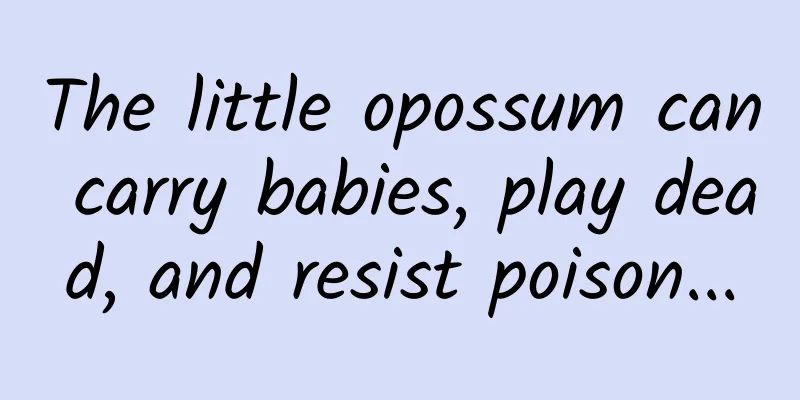The little opossum can carry babies, play dead, and resist poison...

|
At the Tokyo Olympics, balance beam champion Guan Chenchen's "kangaroo shaking hand" move became popular. Kangaroos are very cute animals in everyone's mind. Sometimes they scratch the hair on their chest and belly, not because they are a little itchy, but it is a normal behavior of grooming. People think this behavior is very cute and call it "kangaroo shaking hands". As a marsupial with the word "rat" in its name, the opossum also quickly came to take advantage of the popularity. 1. Descendants of Migrants Most marsupials live in Oceania, but opossums live in America. In fact, North America is the home of marsupials. During the Cretaceous period 125 million years ago, 15 to 20 species of marsupials flourished in North America, diverging from placental mammals and beginning to evolve independently. The world at that time was very different from today. The continents in the northern hemisphere were connected into a large area called Laurasia. Oceania, South America and Antarctica were connected together to form Gondwana, which was separated from Laurasia by the ancient Mediterranean Sea. Around 65 million years ago, some marsupials arrived in South America. 40 million years ago, some of them arrived in ancient Oceania and ancient Antarctica. At that time, Antarctica was not so far south, the climate was warm, and it was very habitable. However, these marsupials did not survive for some reason, but instead migrated to Oceania in large numbers. Everyone knows the story of marsupials in Oceania, where they became the dominant species. To this day, Oceania is still the main habitat for marsupials, with kangaroos being the representative. The fate of the marsupials that remained in the Americas fluctuated as the South and North American continents joined and separated. When marsupials arrived in South America 65 million years ago, dinosaurs had just become extinct and placental mammals had not yet developed, so marsupials flourished. In the following 2 million to 3 million years, marsupials evolved into a variety of new species, such as carnivores such as wombats and marsupial saber-toothed tigers, as well as various herbivores, forming a relatively independent food chain and ecosystem. However, in other continents of the world, placental mammals were also evolving rapidly. They had an advantage over marsupials in reproducing the next generation, and began to gradually replace marsupials in the ecosystem. In North America, except for the North American opossum, all other marsupials became extinct in the face of the strong competitive advantage of placental mammals. Marsupials in South America survived because the land bridge connecting North and South America was interrupted at that time, blocking placental mammals. But the good times did not last long. 2 to 3 million years ago, North and South America were connected again through the Panama Land Bridge. Placental mammals swarmed in, and the only marsupials left in South America were opossums. Today, despite the continued encroachment of human habitats on marsupials, they continue to tenaciously defend their eons-old home. 2. Carry your baby on your back Today, most marsupials, with the exception of the North American opossum, live in Oceania, where there are also animals called opossums, but they are actually possums, not members of the opossum family. Although the opossum's appearance is more in line with the aesthetics of rodents, they are very different from rodents such as mice. In sharp contrast to the opossum's rat-like appearance is their noble sentiment. Every baby opossum has a great mom, and every mom opossum is the greatest mother in the world. Although marsupials also live in their mother's body at the beginning of their lives, they can only rely on a relatively large yolk sac for nutrition and will be born 4 to 5 weeks later. When they are just born, the baby marsupials are not as big as a human little finger and can only crawl into the pouch to continue drinking breast milk. Placental mammals have a placenta that can provide a steady supply of nutrients, so the baby can grow very large in the mother's womb and be born fully developed. Placental mammals have a reproductive advantage over marsupials, and marsupials can only admit defeat. When the babies grow too big to fit in the pouch, they crawl out. At this point, they are still very weak, so the mother carries all of them on her back, wherever she goes, for two or three months. Many mammals can walk on their own right after birth. 3. Strong survival skills The American opossum, a marsupial species, lives alone in North America and has evolved a series of unique survival skills. For example, they will play dead, but not only will they put on a death posture, but also quickly secrete a paralyzing substance in their bodies, which will temporarily stop their breathing and heart rate, and rapidly reduce their body temperature. When playing dead, their brains are highly active, waiting for an opportunity to escape. Therefore, predators who like to eat living things will give up on their own initiative. As for predators who will eat their prey regardless of whether it is dead or alive, the North American opossum will discharge a yellow liquid with the smell of rotting corpses from the scent glands near the anus, making predators think that they are highly decayed and lose their appetite. The North American opossum also uses Newton's first law of motion to "brake" while escaping. Predators often have to rush forward for a distance before stopping, but by then the North American opossum has already turned around and fled. The opossum also has a peptide in its body that resists snake venom, even the venom of rattlesnakes. In the summer grass, ticks suddenly jump out, not only sucking human blood, but also spreading Lyme disease. The opossum eats ticks, but it is not a host for Lyme disease and will not spread Lyme disease. The opossum is also resistant to rabies. Its body temperature is lower than that of many other mammals, so the rabies virus cannot replicate in its body. Therefore, the opossum can neither get rabies nor spread it. |
>>: Salmon said: The way home, no matter how difficult it is, is always "fragrant"!
Recommend
Sleeping is the same as not sleeping! "Fragmented sleep" has become a hot topic! What should I do?
How's your sleep? In recent days, there have ...
What is the largest number you can think of? It turns out that counting is also a science
Ask a child what the largest number he can think ...
Light Lesson - [Little Mushroom] Detailed explanation of how to draw cute Q-version characters, introductory tutorial on how to draw Q-version comic characters
Qingwei Class - [Little Pink Mushroom] Detailed e...
Quick sort algorithm popularization tutorial
[[121950]] Without further ado, let's get int...
A good cosmetics advertisement will make you half successful
Advertisements exist to promote products, but we ...
Would you like to know the 10 tips for Weibo operation and promotion?
Would you like to know about the ten tips for Wei...
We tested a variety of neurotrophic factors and finally found the possibility of regenerating damaged optic nerves | Academician Su Guohui
“Every step you take towards your goal will give ...
Ocean Figures | Gong Yunchong: The First Person to Guard the Nansha Reefs
(Photo source: Ocean Archives WeChat Official Acc...
Why is there always a colored oil layer on the glasses? Can an ultrasonic cleaner clean it?
Many people have had this experience: wearing gla...
International Bird Day | How long have you not heard birds singing? Take this bird guide
When spring comes and flowers bloom, birds fly th...
Tim Draper, the most powerful investor: Capital winter is just an exaggeration
[[154628]] In today's star-studded Silicon Va...
The common coconut tree is not the "indigenous" of Hainan.
If you ask what the most common tree in Hainan is...
Is it good for your health to swallow the phlegm?
Expert of this article: Wang Qian, attending phys...
Looking for the next unicorn: in-depth analysis of three models of AI entrepreneurship
This AI wave looks dazzling, but in fact there ar...
2019 Talent GoGo Breaks into Traffic Dealer "SEO and Application Programming" Free Baidu Netdisk Download
Course content introduction Two modules: "SE...









